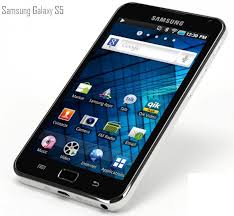Samsung Unveils Water-Resistant Galaxy S5, Leaked Mobiles And Prices
Samsung on Tuesday announced the Galaxy S5, its new flagship Android smartphone with an Apple iPhone 5S-like biometric sensor button. The phone is dust and water-resistant, sports a faster camera and offers fitness-related features.The Galaxy S5, which was unveiled at the Mobile World Congress in Barcelona, Spain, will be available in 150 countries, including India, on April 11. However, the company did not announce the price of the new smartphone.

Galaxy S5, Samsung is going back to basics to focus on delivering the capabilities that matter most to our consumers," said JK Shin, president and head of IT & mobile communications division at Samsung. "Galaxy S5 represents an iconic design with essential and useful features to focus on delivering the ultimate smartphone in the market today through people inspired innovation." Samsung launches flagship Galaxy phone every year after World Mobile Congress (MWC). But, this year, the company announced Galaxy S5 at the MWC because it wants to replace Galaxy S4 as soon as possible."Galaxy S5 users can further customize their experience with an enriched third party app ecosystem and the ability to pair with next-generation Gear products for real-time fitness coaching,"
Galaxy S5, Samsung is going back to basics to focus on delivering the capabilities that matter most to our consumers," said JK Shin, president and head of IT & mobile communications division at Samsung. "Galaxy S5 represents an iconic design with essential and useful features to focus on delivering the ultimate smartphone in the market today through people inspired innovation." Samsung launches flagship Galaxy phone every year after World Mobile Congress (MWC). But, this year, the company announced Galaxy S5 at the MWC because it wants to replace Galaxy S4 as soon as possible."Galaxy S5 users can further customize their experience with an enriched third party app ecosystem and the ability to pair with next-generation Gear products for real-time fitness coaching,"
Another highlight of the phone is a new iPhone-like fingerprint sensor integrated with the phone's home button. The finger scanner will offer a biometric screen-locking feature and mobile payment experience to consumers.The Galaxy S5 sports a 16MP rear camera and a 2.1MP front-facing camera. The rear camera is capable of capturing 4K video at 30 frames per second. Samsung claimed the Galaxy S5 offers the world's fastest auto-focus speed up to 0.3 seconds.The smartphone runs on Android 4.4.2 KitKat, the latest version of Google's mobile operating system. It is IP67 certified dust and water-resistant. The back panel of the phone sports a dimpled soft-touch cover, similar to the Nexus 7(2012) tablet.
SPECIFICATIONS:
It sports a slightly larger 5.1-inch Super AMOLED (1080 X 1920p) display which looks similar to that of the Galaxy S4.Powered by a 2.5GHz quad-core processor and 2GB RAM, the Galaxy S5 will come in 16GB and 32GB internal storage variants, which will be expandable up to 64GB through microSD card.
SPECIFICATIONS:
It sports a slightly larger 5.1-inch Super AMOLED (1080 X 1920p) display which looks similar to that of the Galaxy S4.Powered by a 2.5GHz quad-core processor and 2GB RAM, the Galaxy S5 will come in 16GB and 32GB internal storage variants, which will be expandable up to 64GB through microSD card.

